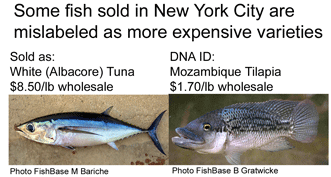 In Pacific Fishing September 2008 (issue available on newstands, not yet on web) two New York City teenagers, Kate Stoeckle (my daughter!), 19, and classmate Louisa Strauss, 18, apply DNA-based identification to fish sold in their Manhattan neighborhood. The girls purchased 60 items from 14 establishments and sent samples to University of Guelph where graduate student Eugene Wong performed DNA barcode analysis. 14 (25%) of 56 samples with recoverable DNA were mislabeled, in all cases as more expensive or more desirable fish. Mislabeled items were sold at 2 of 4 restaurants and 6 of 10 grocery stores/fish markets.
In Pacific Fishing September 2008 (issue available on newstands, not yet on web) two New York City teenagers, Kate Stoeckle (my daughter!), 19, and classmate Louisa Strauss, 18, apply DNA-based identification to fish sold in their Manhattan neighborhood. The girls purchased 60 items from 14 establishments and sent samples to University of Guelph where graduate student Eugene Wong performed DNA barcode analysis. 14 (25%) of 56 samples with recoverable DNA were mislabeled, in all cases as more expensive or more desirable fish. Mislabeled items were sold at 2 of 4 restaurants and 6 of 10 grocery stores/fish markets.
The frequency of mislabeling and the ease of high-schoolers obtaining DNA-based species identifications captured public interest. Their study was featured on page 1 in New York Times on August 22, one of the “quotes of the day” on CNN/Time website, a live segment on CBS TV Early Show, an interview on national public radio, and has appeared in over 350 print and news items and blogs from 34 countries in 10 languages so far, with particularly heavy coverage in China, Korea, and Japan, presumably related to dietary importance of fish in general and sushi in particular.
This response demonstrates how powerful the FishBOL database is already (30,665 barcodes from 5,463 species so far, which represents about 20% of world fish), and hints at enormous uses that DNA barcoding will have as technology gets smaller and cheaper.
The wish of us all is that these DNA barcode analyses become more widespread especially where there is a lot of endangered species trafficking, i.e., tropical countries.
This is such an interesting result but, i wish these restaurants and groceries are informed such that they know our findings and they do not do this stupid thing again.